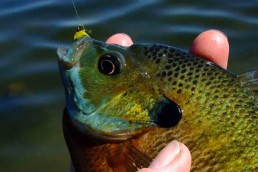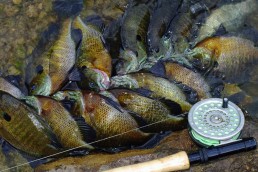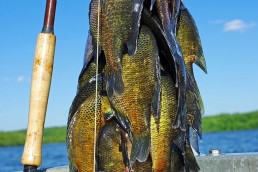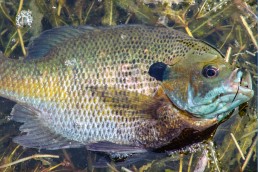Bluegills on Light Fly Gear: Sporty and Tasty
SHARE THIS POST
Fly fishing is the first love of many die-hard anglers. Few things match the inspirational feeling of loading a rod up and shooting a line 40 feet across a cold, clear trout stream. Equally inspiring is the powerful strike of a hard-fighting fish. Consider trying bluegill fishing with a 3 or 4 weight fly rod. The summer months are great for targeting these diminutive fish. They will be feeding voraciously after a long winter.
Bluegills are prolific breeders and are found across the country in ponds, lakes, rivers and streams. Many Fish and Game Departments stock bluegills in new lakes to provide a food source for other species such as bass and catfish. Bluegills are so common that they are often the very first fish a beginner catches.
Bluegills seem to be everywhere in a lake. They often hang out by boat docks and other structures where algae grow. Other baitfish and insects live around these areas and bluegills follow. The opportunities for these are prevalent, and there doesn’t seem to be a bad time to fish for them. They are also a great go-to fish when the action for other species is slow. The bluegill stands alone as a fish that is both “sporty” and great table fare.
These prolific breeders begin gathering on colonies of beds in shallow water in late April and May in the South, and then do so in the North as summer progresses. They will be heavy feeders well into fall, often hanging in deeper water, not far from nesting areas.
The shallow ends of ponds and the backsides of coves in lakes will hold bedding bluegills. Shallow-water spots with little current are the areas to check in streams. Look for shallow, basketball-sized depressions on the bottom at depths of 6 inches to 2 feet. You have found the pot of gold at the end of the rainbow when you find a colony with hundreds of nests in it.
Approach the bedding bluegills with stealth; they will spook easily. If you do spook them from the nests, stay put, as they usually return quickly. Bluegills sometimes nest well into late summer. If you don’t find them nesting, take your search a little deeper around cover.
Are you enjoying this post?
You can be among the first to get the latest info on where to go, what to use and how to use it!
You can easily catch this species bedding from the pond or the bank of a lake. However, a small craft such as a kayak or a belly boat is ideal for approaching and fishing these beds. You can quietly move about without spooking fish and put yourself in the ideal spots. The big advantage of a craft is that you can work big beds or holding areas thoroughly by rotating from spot to spot every few minutes.
Bluegills will defend their nests with great valor. They will attack anything that falls into their nests or near it. Bluegills do have very tiny mouths, so flies should be kept small. Wet flies—with virtually any pattern—will work if cast softly to the nest. Black gnats are a favorite, and a black body with a red tail shows up well. The same flies will work when fished deeper for scattered fish.
For blow-up action, tie on a small popper or rubber spider. Bluegills will make explosive strikes as they clobber any floating bug that gets close. If one misses on the first strike, cast back into the area. They will strike again and again.
Flies can often be difficult to remove from a bluegill’s mouth. Take a popsicle stick and cut a “V” notch in one end—it makes the perfect hook disgorger for this fish.
These fish are delectable on the dinner plate, as their flesh is firm and sweet. Large bluegills at 8 to 12 inches may be filleted like a crappie. Smaller fish can be gutted and fried or baked whole. The backstraps near the spine are where the meat is thickest. Once cooked, the meat should easily flake with a fork.
Bluegills cooked fresh on the pond or creek bank are a special treat. I carry a small, custom “backpacking” stove in my truck and have a few cooking utensils as well. A few years back, I caught dozens of big bluegills at a friend’s farm pond. We decided to have a feast right on the pond bank, even though I was caught shorthanded with no knife or frying pan. So I scrounged around in a nearby junk pile and found an old Mason jar lid and a Ford hubcap. I sharpened the lid on a rock and cleaned my fish. And if you haven’t had bluegills fried in a Ford hubcap, you just haven’t lived.
MWO
SHARE THIS POST
Did you enjoy this post?
You can be among the first to get the latest info on where to go, what to use and how to use it!
Bill Cooper
An inductee to the National Fresh Water Fishing Hall of Fame, Bill Cooper, from the Missouri Ozarks, has written over 4,000 articles on outdoor subjects. You can hear him on Wild at Heart Outdoor radio at espn1073.com.



